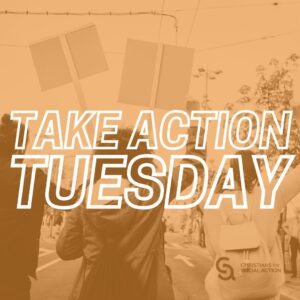Editor’s note: This piece is part 3 of our 4-part series on strategic nonviolent direct action for racial justice. Click here to start at the beginning.
“Freedom only comes through persistent revolt — through persistent agitation.”
– Rev. Dr. Martin Luther King, Jr., Birth of a New Nation
In the summer of 2011, a Canadian anti-capitalist magazine called Adbusters sent “a surrealist poster of a ballerina balanced on the Wall Street Bull, a famous public sculpture near the financial district,” with the words “What is our one demand?” floating above the ballerina’s head [1]. That image was part of a tactical briefing calling people to occupy New York’s financial district and demand change.
balanced on the Wall Street Bull, a famous public sculpture near the financial district,” with the words “What is our one demand?” floating above the ballerina’s head [1]. That image was part of a tactical briefing calling people to occupy New York’s financial district and demand change.
At noon on September 17, that same year, 5,000 protesters reported to Zuccotti Park to answer the call to occupy Wall Street: 300 hundred of them spent the night, vowing to stay encamped there until their undetermined demands were met [2]. Thus, the Occupy Wall Street movement was born.
How Failure Can Make Racial Justice Campaigns Stronger
Years after Occupy ended, people still disagree about its impact and legacy. Some say its preference for decentralized leadership set a precedent for the Black Lives Matter movement. The movement certainly changed the way many Americans talk about economic inequality, by coining the phrase “The 99%.” And its populist message is said to have paved the way for the appeal of Bernie Sanders’ presidential campaign.
Nevertheless, Occupy co-founder Micah White looks back on the movement as “a constructive failure”[3]. He writes:
“Occupy Wall Street failed to live up to its revolutionary potential: We did not bring an end to the influence of money on democracy, overthrow the corporatocracy of the 1 percent, or solve income inequality. If our movement did achieve successes, they were not the ones we’d intended.” [4]
The phrase “constructive failure” is useful for freedom-seekers. It echoes the wisdom of many successful movements. Veteran organizers assume that every ‘failed’ action or campaign has something to teach us. If we’re willing to investigate our actions, we’ll find for practical mistakes and incorrect theories of change. The historic Montgomery Bus Boycott was successful—in part—because Civil Rights leaders reflected on failed bus boycotts in Tallahassee, Florida and Albany, Georgia.
When I reflect on the Occupy movement, I see a common and familiar mistake in today’s activism.
The Activist Mistake That Dooms Racial Justice Movements
Most movements in the United States that have made headlines since the decline of Occupy have made this same mistake: calling for mass action without a clearly defined grand strategy to guide their efforts or a plan to sustain pressure on the system.
Freedom isn’t won in a day. The Montgomery Bus Boycott lasted over a year. It took over a decade for India’s nonviolent movement, led by Mohandas K. Gandhi, to end British rule. It took 10 years for Serbian activists to oust the brutal dictator Slobodan Milosevic.
Historically, freedom movements have won their political objectives through the patient work of building popular support over time. These movements then leveraged their numbers to put consistent pressure on the oppressive system. They also used a variety of nonviolent tactics that disrupted society’s modus operandi and kept their oppressors on their toes.
But that nonviolent force isn’t often built through mass action. The capacity to stage mass actions that matter usually begins by accumulating small wins over time. Those small wins enable nascent movements to recruit and train more participants, little by little.
But many freedom seekers I’ve observed expect to achieve their goals through planning one mass action, or planning to perform the same mass action multiple times. Veteran organizer Daniel Hunter calls these types of tactics “endless actions.”
Understanding the Difference Between Campaigns and ‘Endless Actions’
I have a lot of experience with endless actions. I planned one in the fall of 2016 when local police killed my neighbor during a mental health crisis. My seminary colleagues and I organized a vigil at the police station in protest of the killing, hoping to contribute to the end of police brutality in our city. We called ourselves “Something Disruptive,” but our year-long vigil at the doors of the police station made no direct intervention against police brutality—though we may have made a difference in the lives of those who attended the vigil. By the end of that year, we were depleted.
The year-long vigil is an example of an ‘endless action’ and illustrates the major problem with such never-ending tactics. They don’t escalate. And without escalation, the powerful have less incentive to meet the movement’s demands, and activists have less incentive to keep showing up. It’s demoralizing for people—who have jobs, kids, and other responsibilities—to give their time and energy to keep performing actions that bear little or no fruit. They get tired and go home out of demoralized exhaustion or just plain boredom. The system is counting on us to wear ourselves out on endless, ineffective actions. So the system just waits for us to tire ourselves out.
The alternative to endless actions that don’t escalate is planned campaigns.
Campaigns Defined: Why Campaigns Are So Important for Racial Justice Movements
In nonviolent direct action, a campaign is a coordinated effort to achieve a limited, milestone objective from your vision of tomorrow. Put more simply, a campaign is a plan to keep acting.
When building a campaign, you assume that you’ll need to perform a number of actions to achieve your goal. This prepares your group to think long-term from the start. It also sets your sights on accomplishing the small wins people need to stay motivated and build capacity over time. Small wins help volunteers feel that their actions are making a difference. They also attract newcomers to the movement because everyone wants to be part of a winning team.
Campaigns are also built around concrete, achievable goals—which helps people sustain involvement by giving a clear sense of direction. People are more likely to pick battles they can win. Clearly defining goals that are also realistic gives people a sense of hope that energizes and sustains action.
Hunter explains that campaigns [2]:
- have a specific “target”—the individual or individuals who can make the change—thus focusing limited movement resources;
- use many different kinds of tactics and actions, offering a range of ways for people to join and participate;
- increase the effectiveness of educational events by showing how each action builds on previous steps and moves toward the goal;
- keep up pressure over time in order to win concessions, as opposed to one-time actions that allow the target to simply wait until the storm blows over;
- build leadership at the grassroots and connect with new allies; and
- take the offensive and build their own timeline for change.
3 Phases for Planning Effective Racial Justice Campaigns
- Analyze the conflict situation. You need a deep understanding of the problems you want to solve through direct action. You need to understand:
- which communities and institutions uphold that problem
- how power flows between stakeholders
- which stakeholders are most likely to be your allies and opponents
- what resources you have to advance your goals
- what resources your opponents are likely to use to thwart your movement.
This list isn’t comprehensive, but the above are good questions to begin your analysis.
- Choose objectives. Once you have a clear picture of the conflict situation and your resources, you’re in a position to choose campaign goals. Your research should reveal strategic targets and viable courses of action. Make sure these objectives are consistent with the grand strategy you created and advance your vision of tomorrow. The S.M.A.R.T. framework is helpful in this phase to define specific, measurable, achievable, relevant, and time-bound objectives.
- Design actions. The world of tactics is so much more vast than protest marches and rallies. We’ll dive deeper into the world of tactics in the next part of this series. For now, suffice it to say that you’ll probably need to implement a diverse array of tactics to reach your campaign objectives.
Expert Resources for Planning Racial Justice Campaigns
Here are a few of our favorite resources for campaign planning at the Racial Justice Institute from expert campaign planners:
This colorful resource includes a 3-card series to clarify and simplify the process of movement planning, along with several supplementary cards that provide frameworks and methodologies for everything from power mapping to choosing tactics that support your strategy.
This resource was written by one of the leaders of the successful nonviolent revolution to end the brutal dictatorship of Slobodan Milosevic. This workbook offers a 1.5-day workshop to lead participants through a series of exercises to build an effective direct-action campaign—step-by-step.
Daniel Hunter is a force to be reckoned with, having organized several successful campaigns over the past decade—including halting the construction of a multi-million dollar casino project and playing a key role in the movement to protect the 2020 U.S. election.
From here, you’ll finally be ready to choose specific actions to move you toward your vision for racial justice. Choosing those specific actions is the subject of our next installment. Sign up for our weekly newsletter to make sure you never miss a post.
 Andre Henry is the Program Manager for the Racial Justice Institute at Christians for Social Action and bestselling author of All the White Friends I Couldn’t Keep.
Andre Henry is the Program Manager for the Racial Justice Institute at Christians for Social Action and bestselling author of All the White Friends I Couldn’t Keep.
Works Cited
- White, M. (2017). The End of Protest: A New Playbook for Revolution. Vintage Canada.
- Ibid
- Ibid
- Ibid
- Hunter, D. (2015). Building a Movement to End the New Jim Crow: An Organizing Guide. Hyrax Publications.


